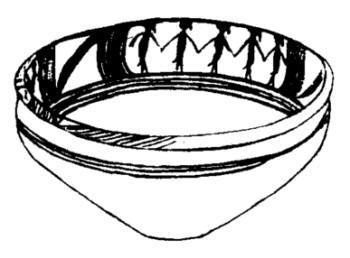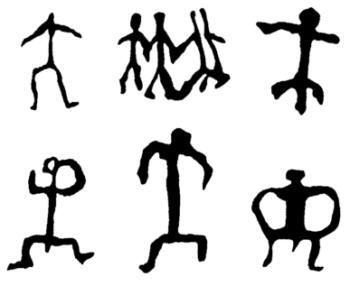Chapter 16 Section 4 Music and Dance
"My fair lady, the music of bells and drums." ("Book of Songs·Zhou Nan·Guan Ju") the music of bells and drums was the embodiment of nobles' demeanor in the Shang and Zhou dynasties.There was also the music of bells and drums in prehistoric times, although there were no real aristocrats then.There is not only the music of bells and drums, but also singing and dancing. The prehistoric difficult life is also full of joy and joy.
Singing, dancing, and music are the earliest art forms of beauty, although they were not considered standard art forms when they appeared, and they did not belong to the category of performing arts without audiences.It is difficult to leave any traces of primitive singing and dancing, especially music, we can no longer hear ancient melodies.However, we can infer the development process of prehistoric music and dance from the various musical instruments left by the ancestors, as well as some ancient rock paintings about singing and dancing scenes.Even the various musical instruments left by the ancestors can be used to find the lost music; the paintings left by the ancestors can be used to imitate the frozen dance.
Primitive music and dance originated in labor. In fact, music and dance were often fixed content in the labor process at first, and belonged to an integral part of the labor as a whole.The hunters of primitive hunting tribes have to rehearse the hunting process before setting off, conduct a drill imitating hunting activities, and also imitate the performance of hunting objects. This is a veritable masquerade.Early petroglyphs discovered in Zuojiang, Guangxi, Cangyuan, Yunnan, and Yinshan, Inner Mongolia all have spectacular pictures of this kind of hunter dance. The spirit of bravery evokes the collective spirit of the people.In this sense, prehistoric dance is a practical art with strong vitality.
Associated with this pre-hunting dance is a kind of dance to celebrate the harvest, which is used to express the joy of hunting and production after the harvest.The dance sometimes involves reenacting the arduous process of obtaining a good harvest, and the props used are practical tools.When the concept of gods shrouded the spiritual world of human beings, music and dance were used to worship and entertain the gods, and there were some fixed procedures and traditional content, so truly beautiful works of art were born.Music and dance are gradually separated from labor and are no longer an accessory of labor, and eventually become a performing art.The most primitive social functions of music and dance can be manifested even in contemporary society, but the lyrical and joyful functions are more prominent.Some purely artistic music and dance may not directly express the emotions of workers, but they can also arouse people's inner thinking and resonate with the audience. This is where the charm of art lies.

Figure 15 Painted pottery basin with dance pattern of Majiayao culture
The beauty of prehistoric dances can be clearly seen from the painted pottery pots with dance patterns of the Majiayao culture we mentioned. The pottery pots depict a group dance scene. The dancers hold hands and walk in a certain rhythm. They sang and danced neatly, and a prehistoric folk painting came to life (Figure 15).The dance scenes depicted in the rock paintings in various places are also very moving, including single dances, duet dances, and spectacular multi-group dances, including hunting dances, masquerade dances, battle dances, sacrificial dances, reproductive witch dances, etc. Some works It belongs to the prehistoric era, that is, works of a later age, which still reflect the style of prehistoric dances, making people feel that they are in the same strain (Figure 16).

Figure 16 Dancers in the rock paintings of Ulanqab, Inner Mongolia
After the appearance of prehistoric music and dance, it was widely used in religion, witchcraft, funeral, swearing-in, celebration and other ceremonies, and thus became more and more popular among the people and became a part of social life.
Any dance, especially group dance, must have a certain rhythm, so accompaniment is indispensable.The rhythm of the early dances was mainly the dancers' own beats and call signs, and sometimes they borrowed some ready-made instruments to beat, thus making percussion instruments, which were the main body of prehistoric instruments.The production of vocal music and instrumental music has an inseparable connection with dance, forming an integrated structure of song, dance and music.
The early rhythmic percussion instruments were mostly based on production tools and living utensils, and the later developed melodic instruments also generally conform to this rule.In this sense, the birth of musical instruments is closely related to the production and life of prehistoric society.The oldest musical instrument in percussion music is the drum. Some prehistoric pottery drums have been found in archeology. They are fired into clay and covered with animal skins.A painted pottery drum was unearthed from the Majiayao cultural site in Minhe Yangshan, Qinghai, which is shaped like a modern waist drum and can be hung up to be struck.In ancient times, there was a saying of "drumming and singing with the pot", and the pot is the pottery pot. It is common for prehistoric people to beat pottery pots to make rhythm.Stones are also commonly used percussion instruments, and large stone flakes can produce crisp music.A large stone flake was unearthed from the Taosi site in Xiangfen, Shanxi during the Longshan period, with a hole drilled in the back, which can be hung up and struck. This is what later generations call the stone chime.The stone chimes of the Bronze Age are smooth and standard-made, and a complete set of chimes can play beautiful and complete movements. Its ancestor is the prehistoric stone chime.In addition, bells and bell-shaped musical instruments that were common later were produced in prehistoric times. There were pottery bells and copper bells in the Longshan period, but not too many were found.
In addition to percussion music, prehistoric wind music was also well developed, with bright timbres and high-pitched melodies, which did not require high performance skills or superb production techniques, so they were valued and loved by prehistoric people.Prehistoric blowing music mainly includes whistle, flute, xun [xun smoke], trumpet, etc., all of which have been unearthed.Both the flute and the whistle are made of animal limb bones. As many as 100 pieces have been unearthed from the Meiyan site in Wujiang, Jiangsu Province, and the Hemudu site.Not long ago, 16 bone flutes were unearthed from a Neolithic tomb in Jiahu, Wuyang County, Henan Province, dating to more than 7,500 years ago.Most of these bone flutes are drilled with seven holes. Through experimental sound measurement, it is known that they already have a seven-tone scale structure with accurate pronunciation, and some of them can still play melody.This is a straight flute, and the owner of the tomb may be a recorder player or a musical instrument maker.The unearthed Jiahu bone flute has led to a re-evaluation of the development level of Chinese prehistoric music in the music industry. In the past, it was always believed that "Chinese music system only has pentatonic scales" and "there is no seven-tone scale in the pre-Qin period". Such conclusions are obviously of no value for discussion. up.
The Xun in ancient China is a very characteristic blowing music. It is made of clay and can be played by holding it in the palm.The origin of this instrument can also be traced back to prehistoric times.A pottery xun with no sound hole was unearthed from the Hemudu site, and two pottery xuns with olive shapes were also unearthed from the Banpo site in Xi'an.Spherical, fish-shaped, and tubular pottery xuns have been found in other places, with blow holes and sound holes.The Xun sound is relatively deep and mellow, which is suitable for expressing the taste of the wilderness. This kind of blowing music may have been very popular in prehistoric times.There is also a kind of pottery horn in prehistoric blowing music. One was unearthed from the Lingyang River site in Juxian County, Shandong Province. It is shaped like an ox horn and can play thick music.It is conceivable that horns made of prehistoric real horns also exist, but they have not been discovered yet.
Whether there were stringed instruments in prehistory, it is still impossible to draw a definite conclusion, and no reliable evidence has been found.
As the enjoyment of beauty, music and dance have long been an indispensable part of modern social life, and have long become an independent art category.In the social life of prehistoric times, music and dance were even more indispensable. Although there were some experts at that time, it was always an activity for the public to participate in. Everyone has talent in this area. Passed down from generation to generation, ensuring the continuous development of this art.

Figure 15 Painted pottery basin with dance pattern of Majiayao culture

Figure 16 Dancers in the rock paintings of Ulanqab, Inner Mongolia
